By Jack Kertesz, MOFGA’s Landscape Coordinator
In my role as landscape coordinator at MOFGA’s Common Ground Education Center in Unity, Maine, I encounter numerous instances where a handcart of some type becomes invaluable in the movement of materials and tools around the grounds. I am particularly sensitive to the shortcomings of some commercially made models and have modified a few or, in some instances, created my own. What follows is a critique of the present world of carts that I have used. This limited analysis may affect your future purchases or inspire you to modify or create a cart of your own. Be aware that while I have heard and considered the opinions expressed by others who have their favorite models, these views are derived from my personal observations over the course of several years.
Gorilla Cart (7 Cubic Foot Model)
I have had numerous opportunities to use the Gorilla Cart as MOFGA has several onsite. Mostly, these carts get used by volunteers on pavement or packed gravel surfaces and on level ground.
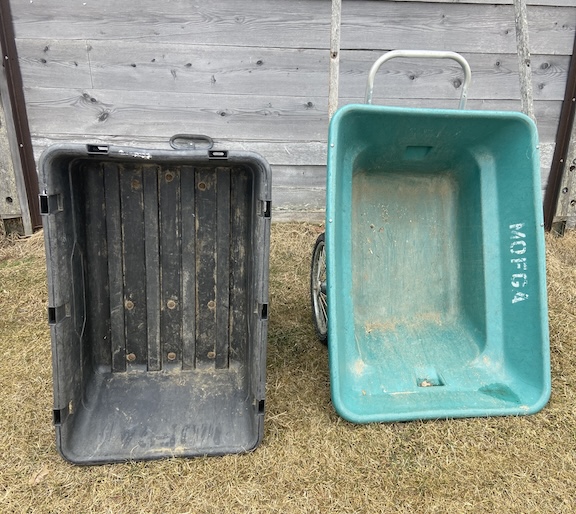
The Handle
The cart’s D-shaped handle allows it to be easily towed behind a golf cart (our electric one helps us scoot around the grounds) and, on occasion, my car, using a trailer hitch with a ball. The handle shaft’s ability to move up or down and the pivoting front wheels both make for easy towing.
The oval handle also allows for one- or two-hand use. Using one hand to pull, however, creates a strain to the shoulder being used, and body alignment becomes askew. When using two hands, the arms are locked behind the back (if walking forward), and this puts quite a strain on both shoulders.
Walking backwards, with arms facing towards the cart, requires some effort to avoid any tripping hazards. Some people have learned that pushing heavy loads is less stressful on the body (such as moving a loaded pallet jack in a warehouse). This is an option on level sites but becomes awkward when traversing any grade while also trying to steer the cart.
The handle height may be problematic for taller people. I often find myself lifting the cart as I pull a load uphill, but I see no practical way to make adjustments.
Wheels
The tires of the Gorilla Cart seem to be prone to getting flats, and we have had to replace many of the original tires. An upgrade to solid tires is possible, but as the rims are of a proprietary size, the investment is costly.
The Bed
The bed is made of plastic, and while appearing pretty rugged, we have had a few that have cracked or broken, likely from extra stress caused by reckless use.
One MOFGA employee drilled holes into several of the beds to allow for drainage; this helps us to avoid surprises like saturated loads of compost following a deluge, which can make moving the cart very difficult.
The size and configuration of the body makes these carts less desirable for hauling multiple bales of hay. They can hold two standard bales, with the top one preferably strapped down. The next larger size cart is probably a better investment if hauling hay is a frequent task.
On unpaved or packed surfaces, extra-heavy loads can be moved but only with some degree of effort and accompanying awkwardness. (When empty, the cart already weighs in at 53 pounds.) The rear-facing push option makes getting started very difficult. Heading down hill with a load behind you can be invigorating; avoid getting run over by moving quickly or by inching the cart down with the load in front of you.
These carts do have a lever that unlocks the bed from the chassis to facilitate dumping and most of the contents gets emptied. It generally works, but the contents sometimes remain in the bed and lifting the cart to empty the entire contents is rather difficult.
Retrofits
While these four-wheel models have their applications, I have not yet tried to modify them in any way, preferring to tinker with the two-wheeled carts.
Smart Carts (7 and 12 Cubic Foot Models)
I have been known to speak out on the shortcomings of these carts, sometimes loudly. I do have friends who really like theirs. Here’s a few of the things I find less than ideal.
The Handle
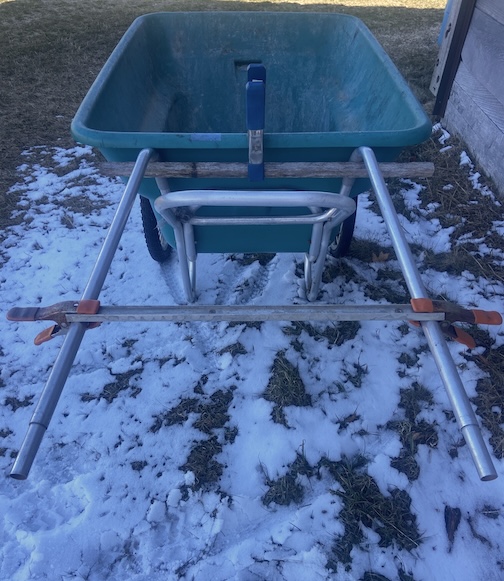
The looped aluminum tubing handle requires one’s wrists to be in an uncomfortable position, as if one were using a keyboard. That is stressful for lifting or pulling and even pushing.
The hand position required to pull these carts aggravates shoulder and neck muscles, especially when walking forward with both hands behind the back. One can pull, using a single hand but that requires a twisting motion, which I find to be stressful on the shoulders, neck, arms, and the back.
The short length that these handles extend from the cart body makes it difficult to control any loads that shift or are weighted forward. I find this to be dangerous, and downright discouraging when loads are accidentally dumped — something that I have experienced several times.
Wheels
These carts come with either spoked wheels or smaller, heavy-duty turf wheels. Though they will support a heavier load, I find the latter much harder to roll around MOFGA’s grounds.
The Bed
While the plastic tub can be handy for holding water for some uses, one should avoid leaving any material in a Smart Cart during rainy spells — as the carts are extremely difficult to move when the contents become saturated.
The angled front does allow for these to be emptied, but that, as well as the location of the wheels, is also what increases the chance of the contents spilling out prematurely.
More recently I have noticed the beds on some of our oldest carts are shedding pieces of plastic, likely from UV exposure and frequent scraping from shovels and forks. In an era where plastic pollution is so prevalent, this is rather daunting.
Retrofits
Shafts, primarily wooden ones, are a part of the design of every cart that has been utilized by cultures where carts were a practical necessity. I modified one of the larger Smart Carts with wooden shafts bolted underneath the lip that runs along the outsides of the plastic bed. This has made a measurable difference in comfort and safety as I can more easily control loads that shift, preventing them from prematurely dumping. Walking forward or pulling the cart behind me is less stressful as both of my hands fall naturally in a plane alongside my body. This modification can also be employed on the 7 cubic foot cart, and the handle width would be more appropriate for average people.
As a quick fix, I have been known to insert a long-handled shovel up through the front hoop, and then have the shovel blade press down on the lip of the bed. Under a load, the lifting action keeps the now extended handle in place. I have used this method several times to traverse the fairgrounds, and it was a relief not to have the usual back strain as well as not getting the back of my ankle nicked by one of the frame legs. One caution, though, is that the shovel can easily disengage from the bed, making this method ill-suited for controlling loads when heading downhill.
While looking for another quick solution, I discovered that the handle section from an aluminum walker fits under the lip of the larger cart, and with the former legs sticking out they act like shafts. Aided by a bit of luck and a collection of cast-off junk, these temporary “fixes” help me evaluate what, where, and sometimes how I can construct a proper retrofit. I can now picture improving this design and installing a 2.0 version on several carts in the future.
Original “Garden Way” Garden Cart
There are a host of imitations of these carts on the market now. The largest model of these allows for carrying four bales of hay at a time.
The Handle
The classic metal tubing that wraps around the cart body is sometimes “affectionately” called a “butt bumper.” Navigating downhill sections while pulling this cart forward makes that a very choice descriptor.
Once again, the horizontal bar configuration contributes to wrist stress when moving forward or backward. Modifying these carts with two straight wooden shafts remains an option. I have seen some mounted on the top edge of the side boards, but a vertical strut of some kind needs to be connected to the base to make this secure.
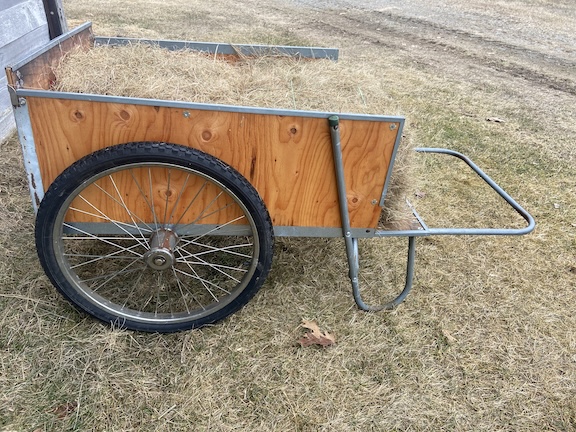
Some folks favor operating these carts by stepping inside the hoop and then pulling forward with a little assistance from their waist area. One must stay vigilant to avoid being run over when using this technique.
Wheels
On the bigger models, the wheels are quite rugged and roll easily enough over any terrain. Any (new or used) 26-inch mountain bike tire will fit on these rims and even extra-wide fat-tire bike tireswill work with a little shaving down of any protruding side fasteners on the exterior walls of the cart.
The Bed
I like that the plywood base and sides can easily be replaced when worn.
My Homemade Carts
My Dad’s Cart
I modified a creation of my dad’s; it originally had two wheelbarrow wheels and a smaller dolly wheel up front to help support and turn the unit, which worked well on pavement. I added shafts (wooden handles that were made to be mounted on a broad fork) and larger wheels. It is a bit funky, but with a stainless-steel bed liner it is very unique and serviceable. This design even had flared extensions for the sides that slid on and off depending on the need, to increase carrying capacity. Two halves cut from a bicycle rim provide for struts underneath to balance loads when parked.
Custom Multi-Platform Cart
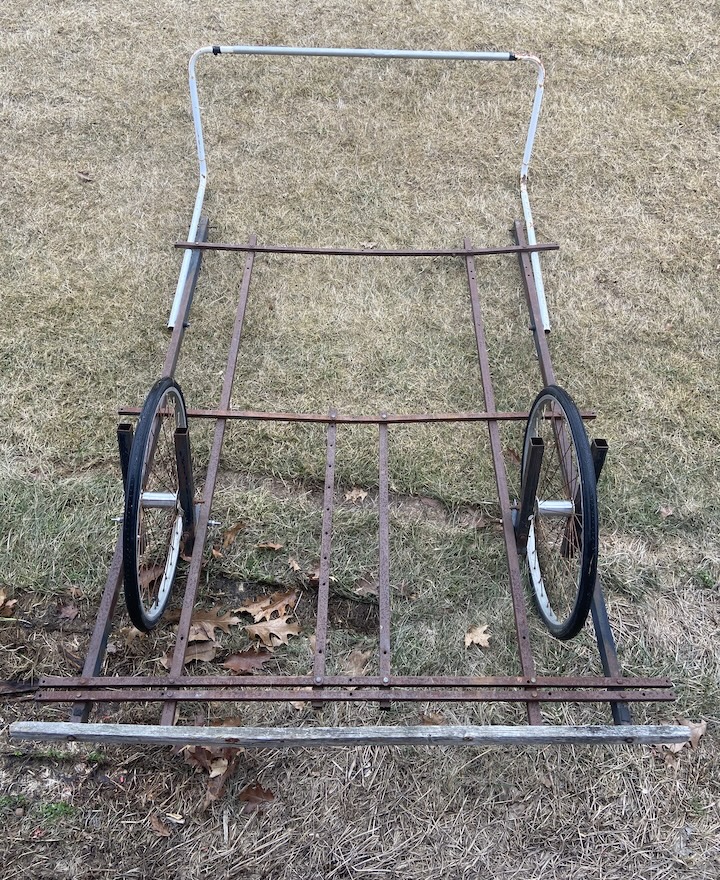
A formidable flatbed for bulky items if the load is balanced properly.
Years ago, I built a two-wheeled frame that supported multiple tasks (and failed at others). Using primarily discarded materials and a few new fasteners, it was my idea of an over-the-bed platform or chassis to accommodate various attachments. At the time, I was using 40-inch-wide beds. I could add row markers to lay out parallel rows for direct seeding or transplanting. The evenness of the spacing was to allow for follow-up cultivation using this same platform (which didn’t work as planned).
I did manage to rig a home-built black plastic mulch layer unit on it, complete with a single reel to simultaneously lay drip tape. A metal roller on the backend helped to smooth and unroll the plastic. First, I needed to create furrows on each side of the bed to provide a place to bury the sides of the plastic. I used a wheel hoe with a plow attachment for this extra step. (I expected to mount two opening plows on each side of the chassis to facilitate this step but never installed them.) The furrow, with the plastic mulch in place, was filled in by two accompanying helpers, using shovels.
As another option, I installed a gang of three EarthWay seeders to plant consistently spaced rows. In reality, this retrofit never got tested. This design could conceivably allow for other attachments, such as: a bed marker, crust breaker/non-powered rotary tiller, roller, smoother (using chains?), dibbler, or grid layout marker. Finally, a removable plywood base could be added for transporting harvest crates, bread trays, seedling flats, irrigation equipment, tomato stakes, hay bales, and hand tools.
Another quickly cobbled together model consists of an inverted (and discarded) frame from a water table from an elementary school, a pair of wheelchair wheels, and some quickly crafted wooden shafts. It has been used to carry three standard bulb crates on the bottomas well as three bread trays perched on top of the shafts (somewhat gingerly). The hoops were an afterthought that happened to fit on the frame. These might support shade cloth or greenhouse plastic. An open platform like this does give you options to transport longer items but also eliminates the option of transporting compost and the like.
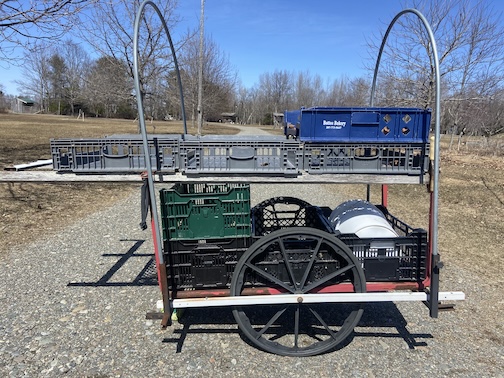
One such feature that could be applied to other carts is an L-shaped horizontal bar, that when placed across the two shafts sticks out on one side. This allows you to walk down garden paths and avoid stepping in the beds, while still offering good control using both hands, with one still on a shaft. I am a bit impressed that this works so well, as it is such a simple add-on feature. A second one could be added to the other side, to share the load with a partner.
Simple builds using mostly scrounged items are fun to work on and help to sort out potential issues when being built or used. Occasionally one arrives at that “Eureka” moment that only occurs when something appears right in front of you. However, purpose-built carts are also something to consider in the planning process. I hope you’ll take some of these cart-smart critiques into consideration to create your own model or to modify your present one.
This article was originally published in the summer 2025 issue of The Maine Organic Farmer & Gardener.